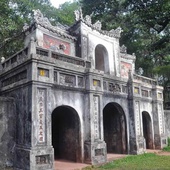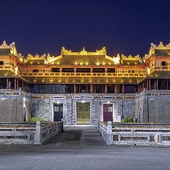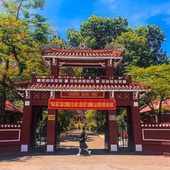Hon Chen Temple
Location
Hon Chen Temple is located on the picturesque slope of Ngoc Tran Mountain, approximately 10 km upstream from the center of Hue. The name "Ngoc Tran" translates to Pearl Bowl, derived from the bowl-like shape of the mountain, which also inspired the temple's name: Hon Chen.
 Aerial view of the Hon Chen Temple festival on the Huong River, Hue
Aerial view of the Hon Chen Temple festival on the Huong River, Hue
Alternatively, some assert that the temple's original name was "Hoan Chen," meaning Return the Bowl. Local legend recounts how a turtle returned a pearl bowl that Emperor Minh Mang accidentally dropped into the river during his visit to the temple. Later, Emperor Dong Khanh renamed it Hue Nam Temple (the temple that brings joy to the King of Vietnam) in gratitude for the assistance of the Mother Goddess Thien Y A Na before his coronation.
A Temple with Many Legends
Hon Chen Temple was initially built to honor Po Nagar, a revered goddess of the ancient Cham people. This tradition was carried on by the Kinh ethnic group. Cham legends attribute the creation of land and nature, as well as the teachings of agricultural practices, to this goddess. Such devotion is part of the rich and mystical worship of goddesses in Vietnam, known as “Dao Mau.”
While the temple dedicated to the goddess has been around for centuries, it featured a simple design until 1832, when Emperor Minh Mang ordered its extensive reconstruction. The main ceremonial hall, Minh Kinh Dai, is a sacred space where hundreds of gods, goddesses, and Buddhas are venerated. The top of the hall features Mother Celestial Thien Y A Na and Lieu Hanh Princess, accompanied by other higher deities.
A notable aspect of Hon Chen Temple's architecture is the depiction of phoenixes, which symbolize femininity in Eastern culture.
Hon Chen Temple is renowned not only for its stunning location but also for the folk festival honoring Mother Goddess Thien Y A Na. This event takes place annually in the months of March and July according to the Lunar Calendar, as reflected in the folk saying:
“July is for worshipping Father, March is for Mother.”
 Hon Chen Temple Festival - Photo: @visithuevietnam
Hon Chen Temple Festival - Photo: @visithuevietnam
The ceremonies during these festivals are deeply solemn. The air fills with the aroma of incense and flickering candlelight, creating a sacred atmosphere in a naturally romantic setting. Celebrations take place not only within the temple but also on specially decorated boats equipped with worship elements, flags, and banners. The ceremonies are held at night, while traditional music, known as “chau van,” resonates amid a flotilla of boats tied together to form larger rafts referred to as “bang.” During this time, the river comes alive, adorned with numerous dragon palanquins gliding upstream and downstream throughout the day.
Traveling by boat is highly recommended for tourists, as the surrounding landscape is breathtaking. Visiting Hon Chen Temple during these exceptional events presents a unique opportunity to experience a traditional religious festival. The festival is said to honor not only “Dao Mau” practitioners but also serves as a celebration and commemoration of motherhood. Such a meaningful fusion of spirituality and belief enriches the cultural fabric of the region!
Useful Information
- Location: Dien Hon Chen, Hue
- Best for: All visitors
- Entrance: N/A
- Hours: 9:00am - 5:00pm
- Distance to city center: 5.5km (3.4 mi)

Tu Hieu Pagoda
In Hue - one of Vietnam's most sacred lands of Buddhism, Tu Hieu is regarded as the largest and oldest pagoda, and also a famous sightseeing spot with historical and cultural value.

Hue Imperial Citadel
Famously being one of Vietnam’s seven UNESCO World Heritage Sites, the Imperial City of Hue has long been a must-see attraction for tourists visiting a hidden charm of Vietnam.

Quoc Hoc Hue - Century Old High School
Being the first and also the oldest high school in Vietnam, originally Quoc Hoc (National high school) was the school for children from royal and noble families.








